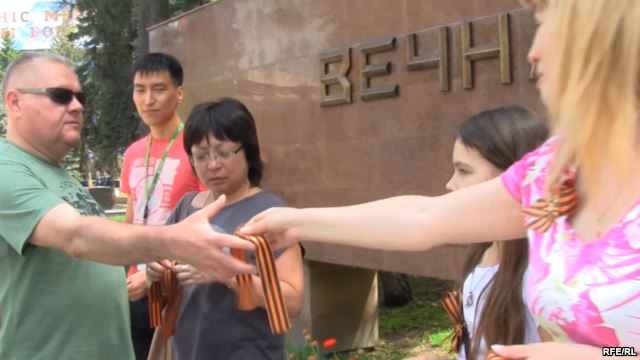
St. George’s Ribbons and Their Dubious Symbolism in Post-Soviet Central Asia
Publication: Eurasia Daily Monitor Volume: 12 Issue: 86
By:

The Embassy of the Russian Federation in Uzbekistan has announced that between April 27 and May 8, to commemorate the 70th anniversary of the Soviet Union’s victory over Nazi Germany in the Great Patriotic War of 1941–1945, embassy staff would distribute free “ribbons of St. George” to the local population (Russia.uz, April 15). The Russian embassy in Tashkent had distributed around 4,000 ribbons in 2013 and 33,000 in 2014.
The orange-and-black-striped ribbon of St. George, a symbol of military valor in Russia, has become a disputed topic in many of the countries of the former Union of Soviet Socialist Republics (USSR)—particularly, ahead of the 70th celebration of the Victory Day of the Soviet Union in World War II. Ten years ago, while marking the 60th anniversary of the Soviet victory over fascism, the Russian media and public figures initiated the “action of the St. George’s ribbon,” whereby the ribbons are worn as an act of the commemoration of the war. Across the post-Soviet space, Russian embassies distributed the ribbons along with a slogan in the memory of the Great Patriotic War. However, in 2014, amidst the Ukrainian crisis, St. George’s ribbons were worn by the opponents of the Ukrainian government, in particular, in Crimea and southeastern Ukraine, as a kind of identification marker for the separatists and pro-Russia activists. Hence, the perception of these ribbons has changed: from symbolizing the Soviet struggle against fascism (although, even in the Soviet Union a red ribbon was used more often), the orange-black ribbon has become a sign of the Kremlin’s covert propaganda and, in extreme ways, it is now associated by many in the post-Soviet space with Russian encroachment on the sovereignty and territorial integrity of their own countries (Newsru.com, May 6, 2014).
Similar concerns have been raised in Uzbekistan, too. A well-known sports journalist, Bobur Akmalov, published a post, on April 20, entitled “Uzbeks, open your eyes!” In it, he explains that the St. George’s ribbon was established not during World War II, but during the Russo-Turkish war of 1768–1774 (by a special decree of Russian Empress Catherine II, on November 26, 1769). The Order was awarded only to those officers of the Russian army who had military status. In the second half of the 19th century (1853–1895), during the conquest of the territories of Turkestan by tsarist Russia, this order and St. George’s ribbons were awarded to military commanders “for the special contribution to the colonization” of the Khanates of Kokand and Khiva and the Emirate of Bukhara—which all existed in what is now Central Asia (Twitter.com, Blogspot.ru, April 20).
In Uzbekistan, the government has not taken any explicit actions against the use or dissemination of the St. George’s ribbons. Public opinion in this Central Asian republic—believed to be one of the most positive toward Russia, in the region (Eabr.org, 2014, accessed May 7, 2015)—accepted the ribbons as a sign of remembrance and respect to all those who participated in World War II. Last year, young people wore it with pleasure, pinning it to their clothing or accessories; and drivers tied it to the antennas of their cars (Anhor.uz, April 17, 2014). At the same time, Uzbekistan has chosen to highlight a generally negative assessment of the Russian involvement in the region by memorializing “victims of Russian and Soviet repressions” (BBC–Russian service, November 6, 2013). In 1999, in an effort to distance his country from its Soviet past, Uzbekistani President Islam Karimov renamed the Soviet-era holiday on May 9th from “Victory Day” to the “Day of Remembrance and Honoring Ancestors.” Moreover, he specifically commemorated Uzbek victims in the fight against fascism (Lex.uz, March 2, 1999).
The list of countries that have limited the use of the ribbon of St. George includes Turkmenistan, Tajikistan, Kyrgyzstan, Kazakhstan, Azerbaijan, Georgia, Ukraine, Moldova and Belarus. They fully or partially abandoned the use of St. George’s ribbons, by either replacing them with their own national symbols or banning their use completely (Z001.kz, April 19).
In early April 2015, a group of 20 Kazakh civil society activists filed a letter to the mayor of Almaty, Akhmetzhan Yesimov, asking him to stop the action of distributing St. George’s ribbons in schools and replace these ribbons with ribbons bearing the blue and yellow colors of the national flag (Azattyq.org, April 10). Likewise, in Kyrgyzstan, in early April, a special commission of Bishkek’s City Hall decided to decorate the city with ribbons in red and yellow, which are the colors of the Kyrgyz Republic’s national flag, calling it a “Ribbon of Victory” (24.kg, April 8). Thus, to avoid issuing a direct ban on the St. George’s ribbons, these countries chose to create local substitutes decorated with national ornaments, while still leaving the orange-and-black ribbons in circulation. It is also noteworthy that these changes were undertaken at the level of local mayors, with the tacit approval from the central governments.
In Turkmenistan, the Russian embassy was not able to hand out St. George’s ribbons, even prior to the events in Ukraine. The authorities in Ashgabat have made it clear that, for Turkmenistan, the use of the ribbons of St. George is unacceptable. These ribbons were used to decorate the Order of Tsarist Russia “For the victory at Geok-Tepe.” The defense of Geok-Tepe (December 1880–January 1881) is a symbol of national courage and heroism in Turkmenistan (Z001.kz, April 19).
On April 16, 2015, during his annual phone-in conversation with the public, Russian President Vladimir Putin said that Russia will not interfere in its neighborhood, as long as there are no local infringements on the rights of Russian populations and use of their native language (RT, April 16). Yet, some of the traditions and commonly held beliefs related to Russian history are becoming increasingly confronted in the other former Soviet countries, which are building their own identities. Textbooks in some post-Soviet republics already stress a narrative focused on World War II in general—not limited to the Great Patriotic War, as was done in the Soviet times. For these nations, the St. George’s ribbon stands as a symbol of a bygone era and of the military glories of another country and another military force.




